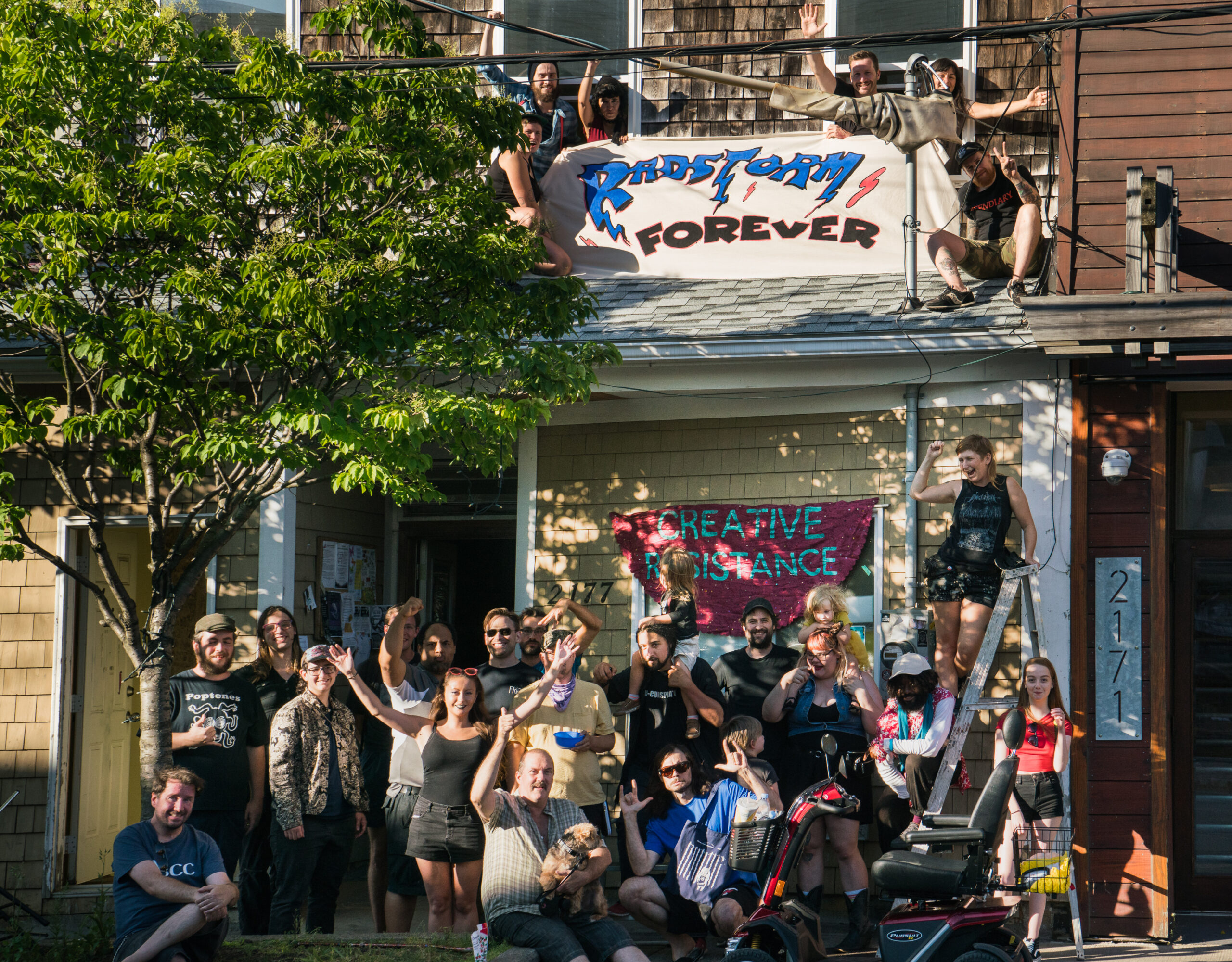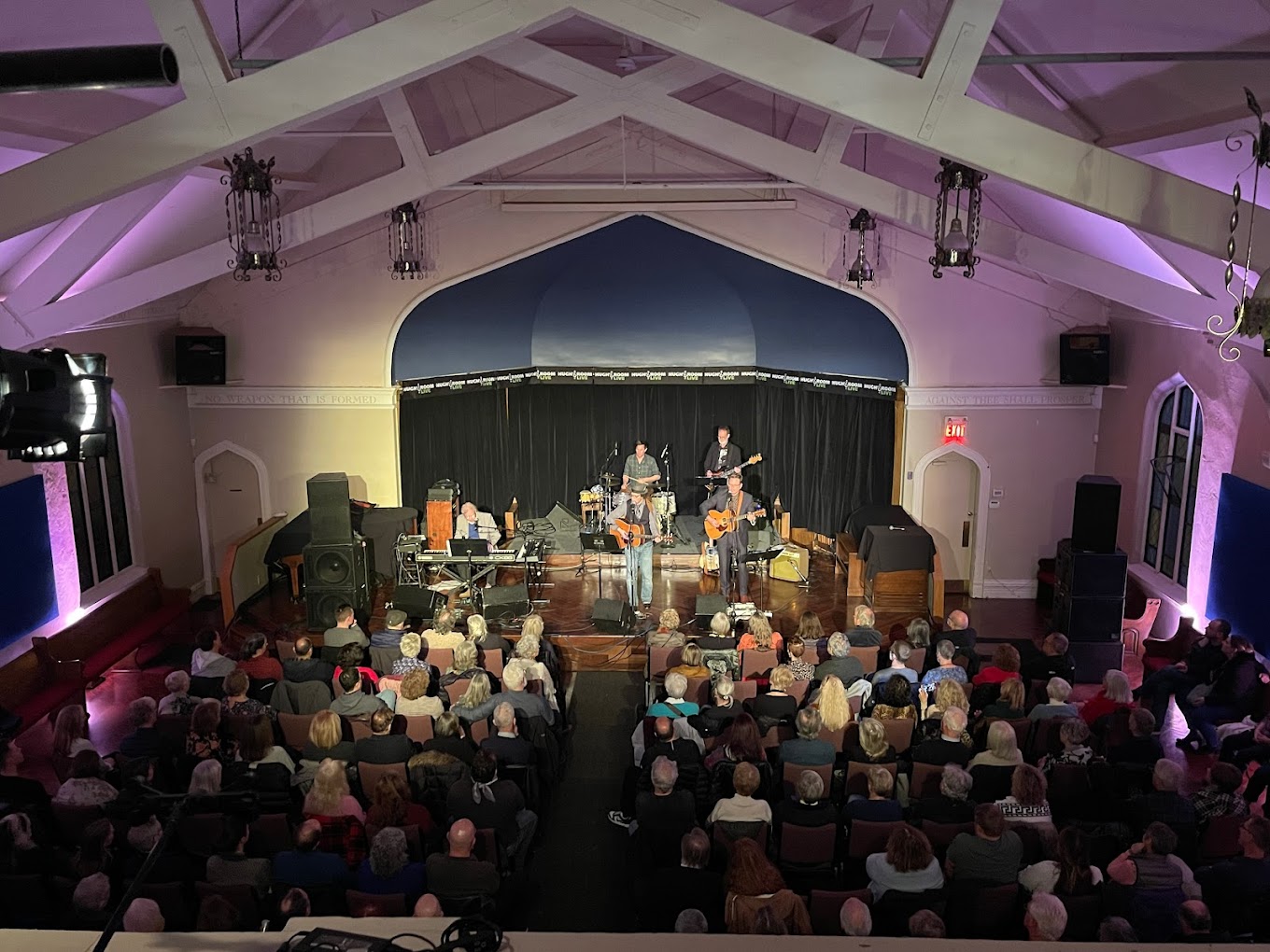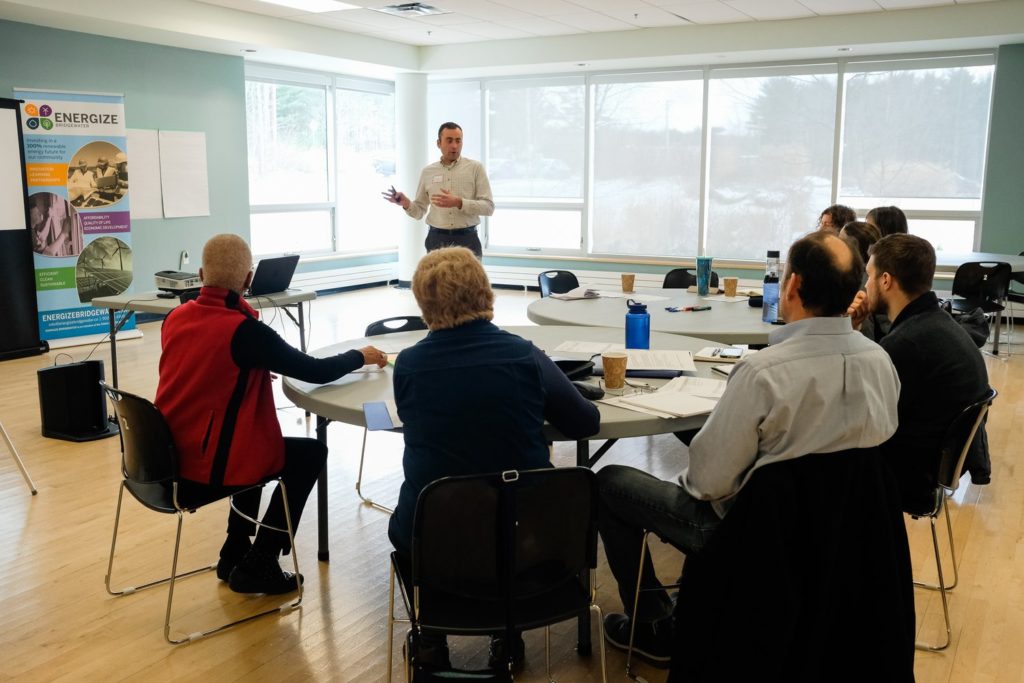client-stories
At RadStorm, a Halifax non-profit space for art, music, events, and community organizing, everyone’s perspective is welcome and valued. And that’s not just a platitude. It’s built into the organization’s governance.
RadStorm co-founder Capp Larsen describes the group as non-hierarchical, with decisions about the space and the future of the collective made among all members. Members are divided into smaller collectives who meet regularly, and all members are invited to gather oncea year or as-needed for overall planning. Anyone and everyone who shares the vision for an anti-oppressive arts space gets a say.
“It’s really special,” Capp says. “It creates a sense of ownership over the space and responsibility around the decisions that we’re making.”

And soon, RadStorm members will really own their space. After several moves over the years due to the Halifax rental market’s volatility, RadStorm is ready to purchase the building they’re operating in. It’s the perfect space, Capp says, meeting all the organization’s criteria, like physical accessibility, affordability, and a central location.
“Every time we move, it is a huge effort,” says Capp. She says she doesn’t know if the organization would survive another move in the current commercial real estate market.
Luckily, the owners of the Gottingen Street building have offered to sell it to RadStorm for a good deal, wanting the property to stay under community stewardship. “It’s an amazing opportunity,” Capp says.
Since launching the campaign in July, community members have bought almost $100,000 in RadBonds. The total goal is $350,000 in community bonds, which will complement an additional $50,000 in donations and $100,000 in government grants. The total $500,000 raised will cover the entire cost of the building and any closing costs associated.
“We looked into quite a few different possibilities on how to purchase the building,” says Capp, “ranging from seeking large government grants to a traditional mortgage to individual members buying the building and RadStorm being a tenant. We explored many different options. We liked the community bonds model the most because it was more financially sustainable than a commercial mortgage, has a realistic timeline for raising funds, and allows the building to be owned and operated by RadStorm far into the future.”
Community bonds also fit RadStorm’s progressive values. “We really like the idea of the interest we’re paying going back to the community members who are supporting us, rather than going into the pockets of a bank,” Capp says.
RadStorm is a hub for arts-lovers and progressive community organizers in the region. With 343 members and 1,000 space bookings every year for events, musical performances, and more, the space is important to people. The space offers an all-ages music venue, recording and rehearsal space, screenprinting studio, zine library, free food servings, and event space. Spaces like it are closing all across Canada — in the midst of an affordability crisis, arts and culture organizations simply can’t afford to keep up with the commercial real estate rental market and remain financially accessible to their communities.
Capp says community ownership could change the course of this crisis. “If more arts organizations could actually own their space and have control over their own space, that means longevity and that the organizations aren’t bouncing from one space to another, and spending the immense amount of resources it takes in order to move every few years,” she says. “Ultimately, it means that those organizations are able to stick around, be more financially sustainable and use their resources towards whatever their mandate is, rather than using their resources towards just trying to keep afloat.”
Capp has been involved with RadStorm for 20 years, since she was 20 years old. “It has been one of the most important spaces of my life,” she says, “learning new skills, meeting new people, and being a part of something that really gives my life purpose. And seeing young people who are starting to get involved, who are the age I was 20 years ago, and are discovering the space and how much it means to them, it’s so incredible. The idea that we would buy the building and have that level of impact on people’s lives for multiple generations is very inspiring.”
RadBonds are on sale until the end of the year, or until they sell out — find more information here.
“To me, there’s no comparison to seeing a really fantastic, completely unknown musician in a small venue,” says Mary Mowbray.
And that’s exactly why Mary joined the board of Hugh’s Room Live, an iconic Toronto music venue that’s hosted thousands of artists since opening in 2001, from big names like Joni Mitchell and Gordon Lightfoot to emerging Canadian talent.
The intimacy of a venue like Hugh’s Room Live brings something special to each performance, Mary says. “You can be feet from the musicians when they’re performing. You can see them talking to their band and you can see the magic that happens in a live performance.”

But it’s not always easy to run a small venue.
In 2020, just before the start of the pandemic and facing rising rent, Hugh’s Room had to close its previous location at 2261 Dundas West. For three years, the organization held virtual performances, and when public health guidelines allowed, hosted performances at other venues around the city. But they knew they wanted a permanent home again. So in 2023, Hugh’s Room Live purchased a new home at 296 Broadview Avenue with the support of more than 2,000 community investors and donors.
Now, Hugh’s Room Live is running another community investment campaign, this time with the goal of raising $1.3 million to help refinance the existing mortgage on the property and reduce their cost of capital. With these savings, the venue plans to expand their programming, build a community space in the basement of the building, and make the space fully accessible — which it currently is not. “That means we can’t accommodate a musician who requires accessibility,” Mary says. “It also limits our audience or puts them in a position where it’s harder for them to get in or they may decide they don’t want to come. We want to be completely accessible.”
When she’s not working on Hugh’s Room Live projects, Mary works in commercial real estate, so she’s observed the phenomenon of community organizations and small businesses being priced out of their longtime neighbourhoods across Toronto. “I’ve seen that for years and years — independent retailers, like an independent coffee shop getting pushed out for a Starbucks. I see the long term sustainability that ownership offers.”
And Mary is excited about community bonds as a pathway to that ownership for Hugh’s Room Live. “The community bond thing, I think, is so cool because it’s so simple and brilliant,” she says. “It’s an investment that gives you a return and it’s guaranteed with a first mortgage on the building. So it’s very secure.”
Community investors can choose between three bonds, with a minimum investment of $1,000. Mary says it was important to create an investment opportunity that was accessible to any live music lover who wants to support the venue while earning both a financial and social return.
“We have to support the arts and we can’t rely on governments to support them,” says Mary. “If there’s stuff that you like and value, then support it. Support it in any way you can. If you like independent coffee shops, go to Red Rocket (in Toronto). If you love independent bookstores, don’t order on Amazon; go to Book City or Scribe. We all make choices…And I think live music has so many many benefits.”
Want to learn more? Get all the details on Hugh’s Bonds here.
In the Town of Bridgewater, 38% of families struggle to afford home energy bills. Seniors, equity-seeking groups, and single parent families are particularly at risk. In order to afford a basic necessity – such as heat – many forgo other essentials, including food, medication, and transportation.
The housing stock in Bridgewater is old and energy inefficient, meaning that many people pay much more than they should to keep their homes comfortable. But the impact extends beyond comfort – energy poverty affects all aspects of life, from education to mental wellbeing. The documentary below captures the very real experiences of Bridgewater residents that are struggling to afford their rising energy bills.
So what is the solution?
Upgrade homes to become more energy efficient, reduce energy bills, keep more money in the pockets of Bridgewater Residents, and create a positive environmental outcome in the process.
Recognizing the needs of their residents, the Town of Bridgewater launched Energize Bridgewater, an ambitious initiative designed to make energy more affordable, accessible, and sustainable. The program has set a target to reduce greenhouse gas emissions by 80% from 2011 levels by 2050 and lift as many as 350 local families out of energy poverty by 2026.
In order to realize these targets, the Town and residents need access to low cost capital to upgrade homes and develop renewable energy projects. The Town has made enormous headway with the launch of their Clean Energy Financing program, which allows residents to access low interest capital of up to $40,000 to retrofit their homes. Upgrades can vary greatly depending on the needs of the home, from the installation of a heat pump, to adding more and better insulation, to installing new windows or solar panels. Under the Town’s expanding program, residents are now supported by a Navigator, who helps them assess their energy efficiency upgrade needs and access all provincial and federal energy efficiency grants to bundle with their financing.
For the past several years, the municipality has also been exploring the potential for a solar or wind community energy project. The Energize Bridgewater team has investigated innovative models from across Canada and conducted a resource study to identify municipally owned or influenced parcels of land that could be feasible sites. Through this research, one element emerged as critical – community participation.

Bridgewater saw the opportunity to engage community members in the energy transition by allowing them to become investors in sustainable energy projects. This would not only unlock additional capital, but contribute to community economic development and community support for the projects.
The Town brought on Tapestry to explore how this could be done, and to design an investment system that could unlock the capital required to meet their long term sustainable energy targets.
The design of the system was multipronged, involving engagement with a diverse array of stakeholders, system mapping, and financial modeling. Central to the investment system is an investment vehicle called a Community Economic Development Investment Fund (CEDIF), a model unique to Eastern Canada, which allows community members to invest in community-based initiatives, make a fair return on their investment, and get tax benefits.
Tapestry also developed an excel-based tool to support the Town’s decision making process to move forward with the implementation of the investment system. This tool allows the user to test out the financial conditions of the three main components of the system – the community energy project, the community-wide home energy efficiency retrofits, and the CEDIF. The tool enables the user to test a wide array of variables, including the number of households to be retrofitted, the power production and export rate for a community energy project, and loan and return rates, among others. The tool then collects key outputs of the system into a consolidated results and analysis page, for an at-a-glance summary.
Below are some of the key takeaways from our work with the Town of Bridgewater:
There is immense potential for impact investment into energy efficiency and community energy projects. Investors are eager to make value aligned investments, but their decision to do so hinges on a sound business model.
Energy efficiency retrofits can offer attractive returns to investors but logistical challenges remain, such as portfolio assembly, repayment, and risk around timing and delivery of retrofits. This is why the majority of impact investment in energy efficiency has been directed to large scale commercial upgrades. Energize Bridgewater is in an advantageous position having already addressed many of these challenges for investors.
The business model for small-scale solar PV and wind energy projects remains challenging in Nova Scotia, and Canada at large without government support in the form of grants and/or subsidies. The attractiveness of the investment opportunity may change drastically with changes in legislation. For example, the new Community Solar Program, expected to be launched by the Nova Scotia Department of Natural Resource and Renewable in Spring 2024, would likely make a small scale community solar project financially viable and attractive to investors.
CEDIFs are an incredible vehicle to mobilize community investment into meaningful community-based projects. Tax advantages to investors mean that lead times are short and capital can be accessed with relative ease. However, hurdles exist around what CEDIFs can and cannot invest in. For example, CEDIFs can only invest in for-profit entities, precluding non-profits (which may arguably create greater community impact) from accessing CEDIF financing.
Municipalities have a key role to play in navigating the energy transition. Through their work to design and launch Energize Bridgewater, the Town of Bridgewater has gained a reputation as a progressive, forward-thinking, and environmentally conscious Town. Their model is replicable and they are now leading the way for other municipalities across Canada that are trying to tackle climate change and energy poverty.
Photo credit: Town of Bridgewater

